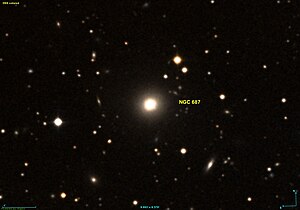NGC 687
| Galaxy NGC 687 |
|
|---|---|

|
|
| AladinLite | |
| Constellation | Andromeda |
|
Position equinox : J2000.0 , epoch : J2000.0 |
|
| Right ascension | 01 h 50 m 33.2 s |
| declination | + 36 ° 22 ′ 15 ″ |
| Appearance | |
| Morphological type | S0 |
| Brightness (visual) | 12.3 mag |
| Brightness (B-band) | 13.3 mag |
| Angular expansion | 1.4 ′ × 1.4 ′ |
| Surface brightness | 12.9 mag / arcmin² |
| Physical data | |
| Affiliation |
Abell 262 LGG 37 |
| Redshift | 0.016982 ± 0.000027 |
| Radial velocity | 5091 ± 8 km / s |
|
Stroke distance v rad / H 0 |
(234 ± 16) · 10 6 ly (71.6 ± 5.0) Mpc |
| history | |
| discovery | Wilhelm Herschel |
| Discovery date | September 21, 1786 |
| Catalog names | |
| NGC 687 • UGC 1298 • PGC 6782 • CGCG 522-017 • MCG + 06-05-014 • 2MASX J01503324 + 3622147 • GC 409 • H III 561 • GALEX ASC J015033.09 + 362215.0 • LDCE 115 NED008 • KPG 42A | |
NGC 687 is a lenticular galaxy of the Hubble type S0 in the constellation Andromeda in the northern sky . It is estimated to be 234 million light years from the Milky Way and about 90,000 light years in diameter. Together with PGC 6807 , it forms the isolated galaxy pair KPG 42 .
In the same area of the sky are u. a. the galaxies NGC 700 , NGC 703 , NGC 704 , IC 1732 .
The object was discovered on September 21, 1786 by the German-British astronomer Wilhelm Herschel .
Web links
- SIMBAD Astronomical Database
- Auke Slotegraaf: NGC 687. Deep Sky Observer's Companion, accessed on September 19, 2015 .
